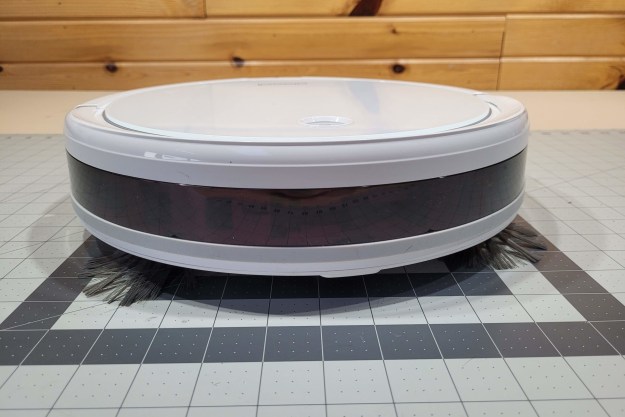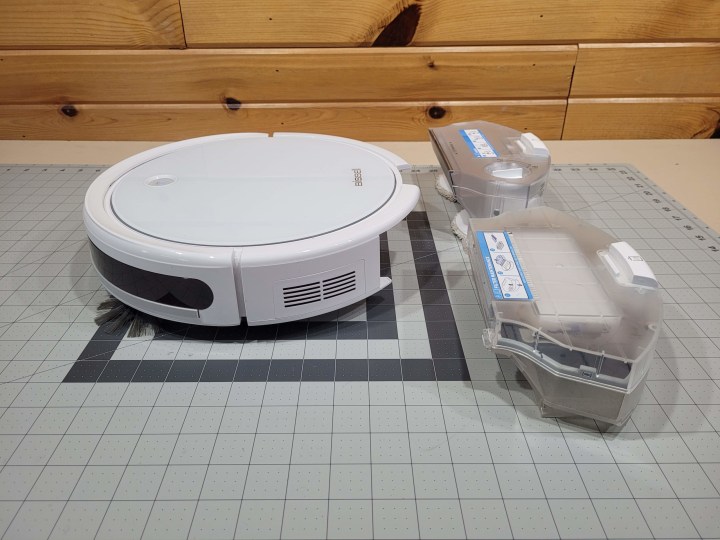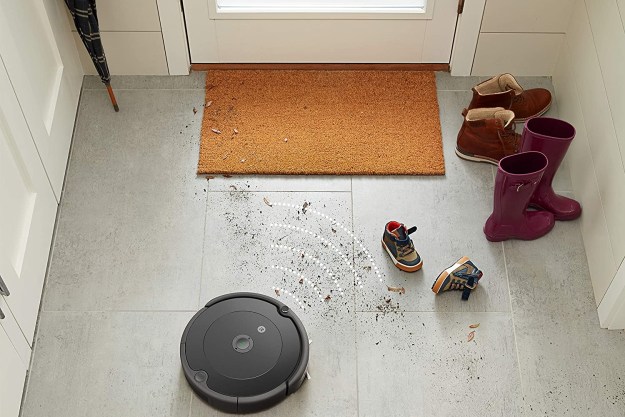
- Simple vacuum, simple interface
- Dry vacuums and mops
- Low profile fits under most furniture
- Easy to change/empty the dustbin
- No bells and whistles
- Inefficient travel routes
I’m probably the worst person to test a robot vacuum. I have two kids and two dogs, my house is a split-level, meaning there are stairs everywhere, and we also vacuum our house maybe quarterly. As a result, our carpet is terrible. But maybe all these things make me perfect for testing out a robot vacuum? So when Bissell asked me to take its latest bot for a spin (no pun intended), I was all-in. Here’s what I found out.
The Bissell SpinWave Wet and Dry Robotic Vacuum is a very low-profile floor sweeper and mopper that covers the very basics of floor cleaning. As the name suggests, there are two modes. The mode is determined by the attachment on the robot. The dirt cup puts the vacuum into dry mode and the mop attachment puts the robot into wet mode. The vacuum itself is short enough to fit under my couch, kitchen chairs, and even the kickplate along my kitchen counters. Those are all pleasant surprises.
No frills
The vacuum (which my daughter named “Turbo”) navigates using optical sensors and bump sensors only. The vacuum does not map out rooms with fancy tech, like the Eufy RoboVac L70 Hybrid with its lidar, nor does it do anything particularly smart. It employs structured gyroscopic navigation (back and forth patterns) and returns to spots it may have missed. The only other sensors are a bottom-facing sensor to prevent driving off ledges, and a soft surface avoidance sensor that prevents the robot from driving up onto carpets and rugs while mopping. This is a basic robot vacuum.
I tested the vacuum on carpet — very dirty carpet — and ceramic tile floors. On both, the vacuum passed the hair and cereal tests, which was good. Some bigger pieces of debris, like lollipop sticks and some cheese stick wrappers did not get picked up. On balance, I would say that the robot vacuum is not as powerful as the upright vacuum we normally use. That being said, the benefit of using a robot vacuum is that you can use it far more often, and even schedule it for night time, or other times I wouldn’t normally be vacuuming. Running a robot vacuum several times over the course of a week will pick up just as much as the upright based on how often we currently use it.
When a vacuum cycle is done, or when the battery gets low, the vacuum finds its way back to its charging station. There, the vacuum charges wirelessly. After several vacuum cycles, the vacuum still finds the charger easily. The setup instructions recommend setting the charging station up in an area with 40 inches of clearance on each side, but I set it up under a chair with less than four inches on each side and the vacuum still found the charger flawlessly.
Works wet and dry
Let’s move on to mop mode. The vacuum comes with a bottle of solution that you mix with water. Simply take the dustbin out and put the mop attachment in. Just like that, you’re in mop mode. The mop attachment has a dustbin that is significantly smaller, but it still can collect dust and dirt before it runs over it with a mop. That’s always a good idea.

While in mopping mode, the vacuum gets very stubborn in small corners. I watched the robot mop the same 4-inch x 1-inch corner for about 10 minutes before it finally maneuvered its way out to the rest of the floor. The robot has algorithms that tell it where to go, but I cannot find a method in the madness. I have no doubt that the vacuum covers the entire floor, but I’m not positive it does so in the most efficient way possible
There are some things that the vacuum doesn’t do that I would like to see improved in a second-generation device. There is no way to block the vacuum out of certain rooms. Since the vacuum doesn’t map your home, you can’t prevent it from wandering into places you don’t want it to go. Even extra sensor barriers that you could purchase separately would be a welcome addition. It would beat the board I placed across the threshold of my son’s room to keep the vacuum out, and the baby gate I used to keep the vacuum in the kitchen.
I initially had trouble getting spot cleaning to work. I found out it’s because I didn’t move the robot to the spot I wanted to clean. Bissell’s support site provided the answer, but there was no prompt in the app to tell me that it could not start a spot clean while still on the charger. I’d also like to see the ability to remotely control the vacuum for a spot clean.
Don’t forget to empty it!
The dust collector fills up very fast. It’s worth repeating I have two kids and two dogs, so I need to empty the dustbin after every cleaning to keep it going. Unfortunately, the robot doesn’t automatically empty the dustbin like the iRobot Roomba S9+, but this is also about a third of the price. Scheduling several cleanings per week is fine, but remembering to empty the dustbin every morning after a cleaning is tough. A notification from the app would be nice.
This vacuum absolutely covers the basics and nothing else, but at this price point, it doesn’t really need to cover anything else.
The outer casing of the vacuum is very prone to scuffs. I mentioned earlier that the vacuum can clean under the kickplates of my kitchen cabinets, but it often came away with a scuff mark that made the vacuum look beat up. Fortunately, the scuffs buffed out with a clean cloth and some cleaner, but it would be nice to see a more scuff-resistant finish in the future.
Finally, the vacuum is not compatible with smart assistants like Google Assistant and AmazonAlexa. This isn’t terrible; it’s more of a footnote actually. It would be nice if you could start a cleaning cycle with a voice command, but to be honest. launching the app or just pushing the start button on the vacuum itself is not difficult.
Our take
Overall, this is a very basic vacuum that offers limited robot vacuum functionality and little else. But that’s perfectly fine because it is available for a low price considering the rest of the field. Normal retail price for this vacuum is $400, which is a steal for a wet/dry vacuum. Even better, at the time of this writing, Bissell is running a sale knocking the price of this down to $250 That is a mind-blowingly great deal.
Is there a better alternative?
Of course! There is no shortage of robot vacuums out there. We have several recommendations that cover the gamut. But there is a ton of value in this package, especially at the reduced price of $250. At that price, it competes with the Lefant M571 Robot Vacuum, which also does mopping. But these vacuums are at the bottom of the price spectrum, and the corners that are cut absolutely do not detract from that overall value.
How long will it last?
The Bissell SpinWave Wet and Dry Robot Vacuum is solidly built out of plastic. Sensors keep it out of harm’s way from drops and falls. The battery is even replaceable. I don’t see any issues with this vacuum lasting for a long time. It comes with a 1-year limited warranty.
Should I buy it?
Yes! For all the compromises this vacuum makes, Bissell is a known brand that has been in the vacuum space for a long time. This vacuum absolutely covers the basics and nothing else, but at this price point, it doesn’t really need to cover anything else. As long as it covers the entire floor, you’re golden. There are more advanced robot vacuums out there for sure, but none for this kind of value and with a brand name.
Editors' Recommendations
- The Narwal Freo X Plus is an entry-level robot vacuum loaded with premium features
- Roborock S8 MaxV Ultra vs. Roborock S8 Max Ultra: Which is the better robot vacuum?
- Roborock S8 MaxV Ultra vs. Roborock S8 Pro Ultra: Which is the best robot vacuum?
- Robot vacuum deals: Roomba, Shark, eufy and more
- The best pool robot vacuums








